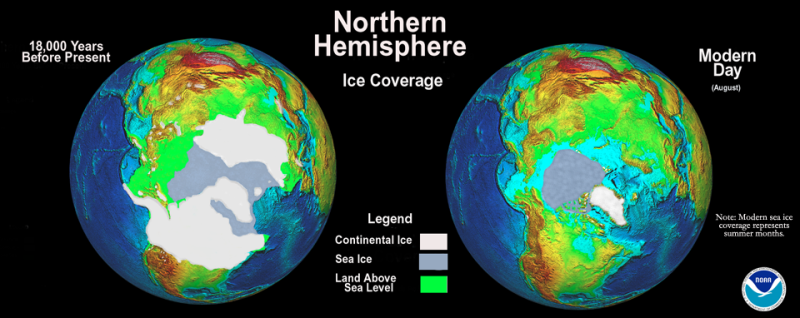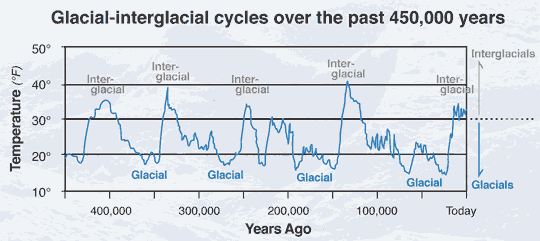Glacial and interglacial periods
An ice age is a period of time where global temperatures drop so significantly that glaciers advance and encompass over one third of Earth’s surface both laterally and longitudinally. During an ice age, a glacial is the period of time where glacial advancement occurs.[1] Similarly, an interglacial or interglacial period is the warmer period of time between ice ages where glaciers retreat and sea levels rise.[2] Over the last 450,000 years, glacials have lasted anywhere from 70,000 to 90,000 years whereas interglacials last approximately 10,000 years.[3]

Another major difference between glacials and interglacials are the changes in sea level. During a glacial, sea levels drop an average of 100m as water is evaporated and stored in the growing glaciers and ice sheets. During an interglacial, sea levels rise as ice sheets and glaciers melt with the increase in temperature, thus resulting in an increase in volume of the ocean as water is heated.[4] However, due to the combustion of fossil fuels resulting in an increase in global warming, the icecaps are melting at a more rapid pace annually—raising the sea level by an average of 3.2 mm/yr and over 70 mm since 1995.[5]
Presently, we are experiencing an abnormally long interglacial called the Holocene that has lasted nearly 11,000 years. A new glaciation has been expected to begin; however, due to human induced climate change or anthropogenic climate change, the next glaciation is being delayed anywhere from a few thousand to hundreds of thousands of years. Therefore, it is expected that the Holocene interglacial may last at least another 150,000 years.[6]

For Further Reading
For further information please see the related pages below:
- Ice age
- Rising sea level
- Glacial lake outburst flood (also called GLOFs
- Glacier
- Climate change
- Or explore a random page
References
- ↑ S. Marshak, Earth: Portrait of a Planet, 3rd ed. New York: W.W. Norton, 2008. Part VI, pp. 791 & 797. [Accessed: 02-Mar-2018].
- ↑ 2.0 2.1 “Glacial-Interglacial Cycles | National Centers for Environmental Information (NCEI) formerly known as National Climatic Data Center (NCDC).” [Online]. Available: https://www.ncdc.noaa.gov/abrupt-climate-change/Glacial-Interglacial%20Cycles. [Accessed: 02-Mar-2018].
- ↑ S. G. Philander, Ed., Encyclopedia of global warming and climate change, vol. 2, 3 vols. Los Angeles: SAGE, 2008. pp. 519-522.
- ↑ Poore, R.Z., Williams, R.S., Jr., and Tracey, Christopher, 2000, "Sea level and climate", U.S. Geological Survey Fact Sheet 002–00, 2 p., [Online]. Available: https://pubs.usgs.gov/fs/fs2-00/. [Accessed: 12-Mar-2018].
- ↑ NASA, "Climate Change: Vital Signs of the Planet: Sea Level", [Online]. Available: https://climate.nasa.gov/vital-signs/sea-level/. [Accessed: 12-Mar-2018].
- ↑ Ganopolski, A., Winkelmann, R., Schellnuber, H. J., “Cristical insolation – CO2 relation for diagnosing past and future glacial inception”, Nature, vol. 529, p. 200, Jan 2016.
- ↑ Utah Geological Survey. “Glad You Asked: Ice Ages – What are they and what causes them?". [Online]. Available: https://geology.utah.gov/map-pub/survey-notes/glad-you-asked/ice-ages-what-are-they-and-what-causes-them/.[Accessed: 12-Mar-2018]

